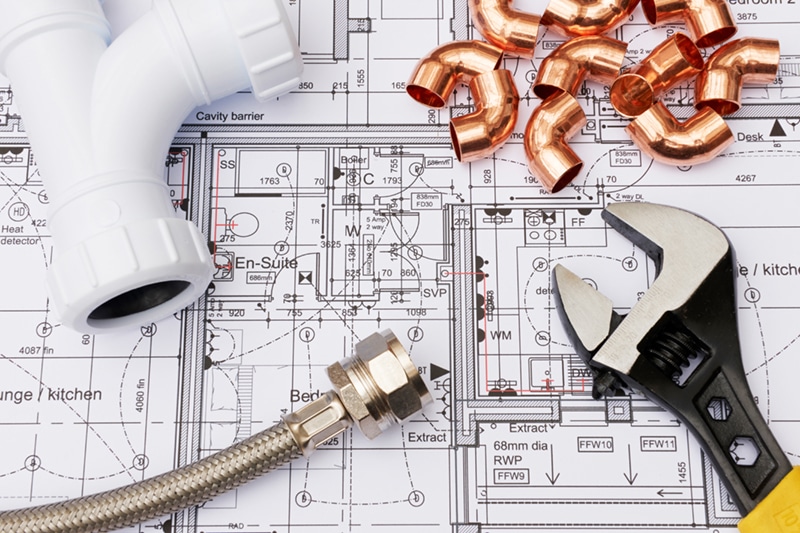
Your home’s plumbing system is essential to your overall comfort, covering everything from bathing, showering and washing dishes to washing your clothes and cooking. At Mission AC & Plumbing, we’re dedicated to helping you understand as much as possible about your plumbing system, which is why in this blog we will cover more about how long your plumbing system lasts, signs to look out for that could indicate it’s time for a replacement and the basics of repipe plumbing.
The Lifespan of Residential Plumbing Systems
In regards to how long you can expect your home’s plumbing system to last, it boils down to the type of material your pipes are made from:
Galvanized Steel
These pipes can last anywhere from 20 to 50 years. However, if you have galvanized steel pipes in your home, it’s best that you plan to replace them as soon as possible. This is because they’re among the worst piping material to have. In fact, they haven’t been used since the 1960s because they rust from the inside out and are prone to hard water deposits that lead to harmful buildup. You might already have noticed a weak water flow or spots of rust.
Copper
Copper pipes can last longer than 50 years and are a step up from galvanized steel. While copper pipes can corrode, they do so at a slower rate when compared to their steel counterparts. It’s the overall quality of your home’s water that determines just how long these pipes will last. Additionally, keep in mind that you want to ground copper piping but not any appliances they flow to.
Cast Iron
Cast iron pipes have been known to last as many as 50 to 60 years, but again, this can vary. One of the great things about having cast iron pipes is the fact that they can last quite a while before any rusting occurs.
PVC
These pipes have a lifespan of about 50 to 80 years. Black PVC, also known as ABS, is commonly found inside the home. PVC is used to connect the house to the street.
No matter what type of pipes you have in your residence, it’s best that you have them professionally inspected at least once a year so you know what kind of condition they’re in and if you should plan on getting a replacement plumbing system in the future. This will keep damage from hard water and other factors from sneaking up on you.
Signs That It’s Time For a Replacement
Now that you have a better idea of how long your home’s pipes are likely to last, it’s time to learn more about the telltale signs that you need to replace worn-out plumbing. These include:
- Leaky faucets: Before ripping out your entire plumbing system, you’ll want to check to see if a simple faucet replacement will do the trick.
- Slowly emptying sinks: These could have a lack of proper venting rather than an actual clog.
- Reduced water pressure: Sometimes, proper venting when plumbing is first installed is skipped to save money, which only costs you later on.
- Persistent drain clogs: A clog that won’t go away despite your best efforts could mean the drain need to be replaced, but it could be that the pipe has corroded and needs to be thrown out. Seek professional advice to be sure.
- Noxious smells: This is an indicator that you may need to replace at least part of your plumbing system. Whether the cause is a broken or blocked sewer line or simply a water seal in the drain, get this checked out, especially if the stacks of your older home are galvanized or cast iron.
The Cost of Re-Plumbing
If you find yourself having to install a new plumbing system, one of your first questions is likely how much you can expect to spend. Some factors include:
- The number of fixtures you have in your home: Fixtures are showers, toilets, sinks and other things that require a supply line. Every fixture will need to have a new incoming line and secondary drain, which inflates the cost of your replacement.
- The overall size of your home: Bigger homes are more labor and time-intensive, and they also need more piping material than smaller homes. Two-story properties cost more because plumbers will have to work their way through the walls to get the job done.
- The new pipe material: While you may want to go with the least expensive option, a less dependable material break down earlier and cost you more in the long run. A quality plumber will help you weigh your options.
- Whether a permit is required: If a contractor needs a permit before continuing with the project, that cost is added to your final bill. Local codes might have changed since your plumbing system was initially installed, and you can expect to pay for that as well.
There’s a lot to consider when it comes to repiping your home and getting your plumbing system back in working order. Mission AC & Plumbing is here to help you get as many years as possible from your plumbing and fixtures.
Reach out to us if you have any questions or would like professional tips.



